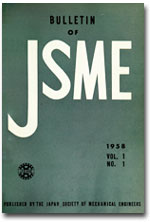Volume 4, Issue 13
Displaying 1-27 of 27 articles from this issue
- |<
- <
- 1
- >
- >|
-
1961 Volume 4 Issue 13 Pages 1-5
Published: 1961
Released on J-STAGE: February 15, 2008
Download PDF (883K) -
1961 Volume 4 Issue 13 Pages 6-11
Published: 1961
Released on J-STAGE: February 15, 2008
Download PDF (593K) -
1961 Volume 4 Issue 13 Pages 11-16
Published: 1961
Released on J-STAGE: February 15, 2008
Download PDF (624K) -
1961 Volume 4 Issue 13 Pages 16-20
Published: 1961
Released on J-STAGE: February 15, 2008
Download PDF (610K) -
1961 Volume 4 Issue 13 Pages 20-25
Published: 1961
Released on J-STAGE: February 15, 2008
Download PDF (646K) -
1961 Volume 4 Issue 13 Pages 26-32
Published: 1961
Released on J-STAGE: February 15, 2008
Download PDF (1088K) -
1961 Volume 4 Issue 13 Pages 33-40
Published: 1961
Released on J-STAGE: February 15, 2008
Download PDF (910K) -
1961 Volume 4 Issue 13 Pages 41-45
Published: 1961
Released on J-STAGE: February 15, 2008
Download PDF (697K) -
1961 Volume 4 Issue 13 Pages 46-51
Published: 1961
Released on J-STAGE: February 15, 2008
Download PDF (813K) -
1961 Volume 4 Issue 13 Pages 51-58
Published: 1961
Released on J-STAGE: February 15, 2008
Download PDF (774K) -
1961 Volume 4 Issue 13 Pages 59-66
Published: 1961
Released on J-STAGE: February 15, 2008
Download PDF (812K) -
1961 Volume 4 Issue 13 Pages 66-76
Published: 1961
Released on J-STAGE: February 15, 2008
Download PDF (1078K) -
1961 Volume 4 Issue 13 Pages 77-86
Published: 1961
Released on J-STAGE: February 15, 2008
Download PDF (904K) -
1961 Volume 4 Issue 13 Pages 87-93
Published: 1961
Released on J-STAGE: February 15, 2008
Download PDF (776K) -
1961 Volume 4 Issue 13 Pages 94-101
Published: 1961
Released on J-STAGE: February 15, 2008
Download PDF (1098K) -
1961 Volume 4 Issue 13 Pages 102-106
Published: 1961
Released on J-STAGE: February 15, 2008
Download PDF (584K) -
1961 Volume 4 Issue 13 Pages 107-114
Published: 1961
Released on J-STAGE: February 15, 2008
Download PDF (1001K) -
1961 Volume 4 Issue 13 Pages 115-123
Published: 1961
Released on J-STAGE: February 15, 2008
Download PDF (1603K) -
1961 Volume 4 Issue 13 Pages 124-131
Published: 1961
Released on J-STAGE: February 15, 2008
Download PDF (894K) -
1961 Volume 4 Issue 13 Pages 131-141
Published: 1961
Released on J-STAGE: February 15, 2008
Download PDF (1188K) -
1961 Volume 4 Issue 13 Pages 141-148
Published: 1961
Released on J-STAGE: February 15, 2008
Download PDF (960K) -
1961 Volume 4 Issue 13 Pages 148-153
Published: 1961
Released on J-STAGE: February 15, 2008
Download PDF (1037K) -
1961 Volume 4 Issue 13 Pages 154-161
Published: 1961
Released on J-STAGE: February 15, 2008
Download PDF (1086K) -
1961 Volume 4 Issue 13 Pages 161-168
Published: 1961
Released on J-STAGE: February 15, 2008
Download PDF (1006K) -
1961 Volume 4 Issue 13 Pages 169-175
Published: 1961
Released on J-STAGE: February 15, 2008
Download PDF (830K) -
1961 Volume 4 Issue 13 Pages 175-182
Published: 1961
Released on J-STAGE: February 15, 2008
Download PDF (890K) -
1961 Volume 4 Issue 13 Pages 182-192
Published: 1961
Released on J-STAGE: February 15, 2008
Download PDF (1659K)
- |<
- <
- 1
- >
- >|
